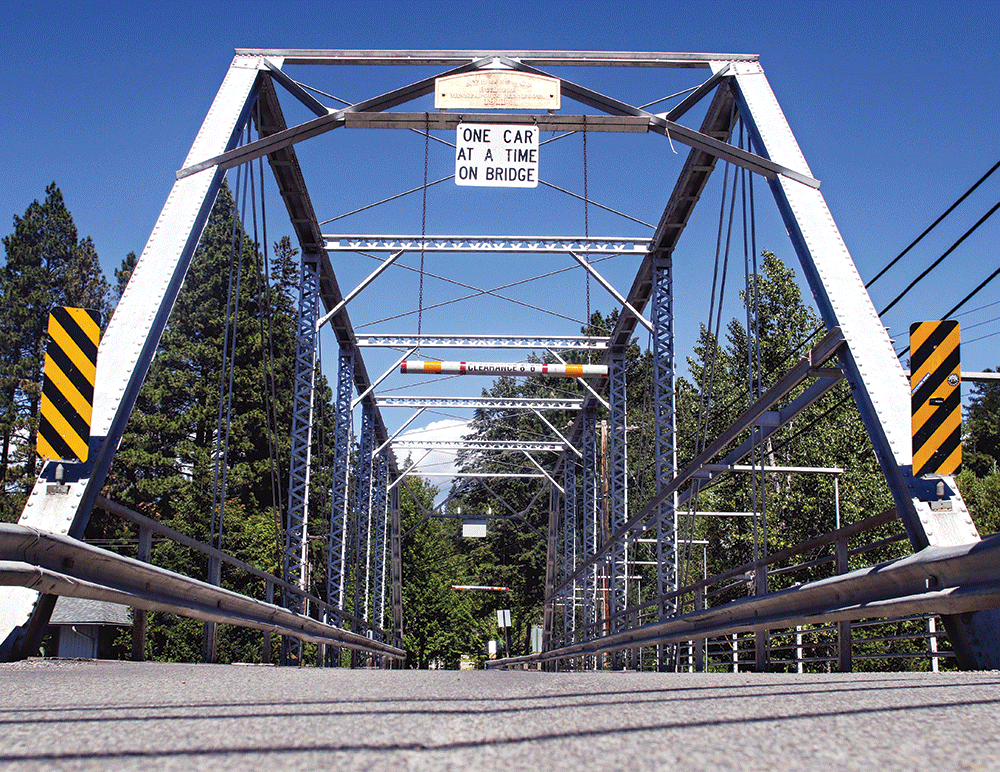Nearly 40 Bigfork community members packed into the Bigfork Elementary School cafeteria Aug. 16 to learn about and comment on rehabilitation or replacement options for the iconic but deteriorating Swan River Bridge.
After an initial open house in April, the Montana Department of Transportation worked with Flathead County, construction firm KLJ, and members of the Community Foundation for a Better Bigfork to develop seven options based on public feedback and three primary criteria. The final option ultimately selected must have the structural integrity to ensure safe passage for vehicles and pedestrians, maintain the historic appearance, and be fundable by MDT and maintainable by the county, which owns the bridge.
Some 3,000 vehicles cross the bridge everyday during summer. It currently has a three-ton weight limit, the lowest permitted before closure, which prevents passage of most SUVs and some trucks. Without action, the bridge’s load limit will continue to decrease, and the 100-year-old one-lane bridge and walkway would likely be deemed structurally deficient in five years’ time, according to MDT officials.
The bridge was added in 2015 to the National Register of Historic Places, a designation that has, in part, prompted this study of replacement options. There is steep competition for the approximately $35 million annual MDT statewide bridge budget, and bridges are typically restored in the most cost-effective manner, according to the agency. But pricier options that would maintain the historical designation or architectural look will be considered, so long as the community expresses full support, MDT says.
All seven options are fundable, according to Chris Hardan, an MDT bridge engineer, but the “level of risk (of obtaining full funding) goes up the more expensive the project gets. It’s definitely not off the table if the community wants that complete rehabilitation. MDT is willing to work with them.”
Option five, the complete rehabilitation of the bridge, is one of the most expensive choices and the only one likely to maintain the historic designation. The closest budget compromise is option three, which would entail the construction of a new steel girder bridge on top of which the existing trusses could be placed in order to preserve the architectural look.
All other options, aside from the first option of no construction, would have visual elements of modern construction. Option six is the only choice with a two-lane design. Option four has the cheapest and most utilitarian design, resembling most standard concrete bridges without any truss feature. Option seven would maintain the overhead truss feature; option two would have a pony truss.
Community members can request a copy of the document detailing all seven options by calling the Department of Transportation at 444-9229.
Before Sept. 16, the deadline for comments, community members must weigh the value of an historical designation against aesthetic, safety, and budget concerns, and decide where to compromise.
“We’re very fortunate to have MDT stepping up to the plate saying they may have funds available to help us with this because if the county had to do it themselves, there’s no way we could get it done,” Commissioner Pam Holmquist told the crowd. “It may end up that you wouldn’t have a through bridge if we don’t seize the opportunity to get their support through this process.”
Before presenting the final feasibility study in late fall, the steering committee will review public comments and select two primary options to analyze in depth.
Community members can submit comments online, or by contacting MDT Project Manager Wade Salyards at 444-0451 or [email protected], or MDT District Administrator Ed Toavs at PO Box 7039, Missoula, Mt 5907-7039.
